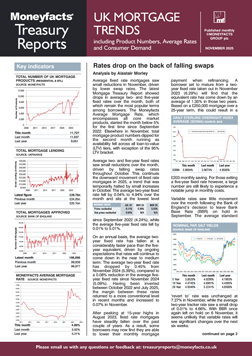Rachel Springall, Finance Expert at Moneyfacts, said:
“The flourishing choice of low deposit mortgages will no doubt be welcomed by borrowers who are either looking to remortgage or are a first-time buyer. The Government has been clear that it wants lenders to do more to boost UK growth, and so a rise in product availability for aspiring homeowners is a healthy step in the right direction. However, there is still much more room for improvement, particularly as the choice of deals at 95% loan-to-value represents just 6% of all deals available to borrowers across fixed and variable mortgages. The end of Stamp Duty Land Tax (SDLT) relief last month could also be playing its part to incentivise lenders to push out more deals to entice new business. Mortgage affordability for borrowers with small deposits has also improved month-on-month, as there has been a drop in rates. The average two-year fixed mortgage rate for borrowers with a 5% deposit at 5.81% is its lowest point in over two years (5.54% - October 2022).
“Throughout March there was minimal movement to swap rates, which spelled a stable situation on the average shelf-life of a mortgage, rising to 21 days from 16 a month prior. This stability was further enhanced by a hold to the Bank of England base rate during March, with another announcement now not due until May. There are numerous murmurings of a potential cut to surface in the coming months, but this could be delayed if inflation gets out of control. However, borrowers dissatisfied by a lack of cuts would be wise to keep in mind that lenders can reduce rates regardless of base rate moves. If the swap rate market plummets, this usually gives lenders a reason to slash their ranges in response.
“Fixed mortgage rates are down year-on-year, and slowly the market is seeing the average two-year fixed getting closer to its five-year counterparts, now with a rate gap of just 0.14%. Since October 2022, the average two-year fixed rate has been higher than the five-year rate. It seems an end to such inversion could be coming, but this does largely depend on how swap rates will move in the coming weeks. These moves make it essential for borrowers not to delay finding a new deal, particularly if they are sitting on a revert rate. However, with the lowest rate mortgages grabbing the headlines, it’s vital borrowers seek advice to find the most appropriate package for them, and not just be swayed by the initial rate.”
Rachel Springall, Finance Expert at Moneyfacts, said:
“The flourishing choice of low deposit mortgages will no doubt be welcomed by borrowers who are either looking to remortgage or are a first-time buyer. The Government has been clear that it wants lenders to do more to boost UK growth, and so a rise in product availability for aspiring homeowners is a healthy step in the right direction. However, there is still much more room for improvement, particularly as the choice of deals at 95% loan-to-value represents just 6% of all deals available to borrowers across fixed and variable mortgages. The end of Stamp Duty Land Tax (SDLT) relief last month could also be playing its part to incentivise lenders to push out more deals to entice new business. Mortgage affordability for borrowers with small deposits has also improved month-on-month, as there has been a drop in rates. The average two-year fixed mortgage rate for borrowers with a 5% deposit at 5.81% is its lowest point in over two years (5.54% - October 2022).
“Throughout March there was minimal movement to swap rates, which spelled a stable situation on the average shelf-life of a mortgage, rising to 21 days from 16 a month prior. This stability was further enhanced by a hold to the Bank of England base rate during March, with another announcement now not due until May. There are numerous murmurings of a potential cut to surface in the coming months, but this could be delayed if inflation gets out of control. However, borrowers dissatisfied by a lack of cuts would be wise to keep in mind that lenders can reduce rates regardless of base rate moves. If the swap rate market plummets, this usually gives lenders a reason to slash their ranges in response.
“Fixed mortgage rates are down year-on-year, and slowly the market is seeing the average two-year fixed getting closer to its five-year counterparts, now with a rate gap of just 0.14%. Since October 2022, the average two-year fixed rate has been higher than the five-year rate. It seems an end to such inversion could be coming, but this does largely depend on how swap rates will move in the coming weeks. These moves make it essential for borrowers not to delay finding a new deal, particularly if they are sitting on a revert rate. However, with the lowest rate mortgages grabbing the headlines, it’s vital borrowers seek advice to find the most appropriate package for them, and not just be swayed by the initial rate.”









